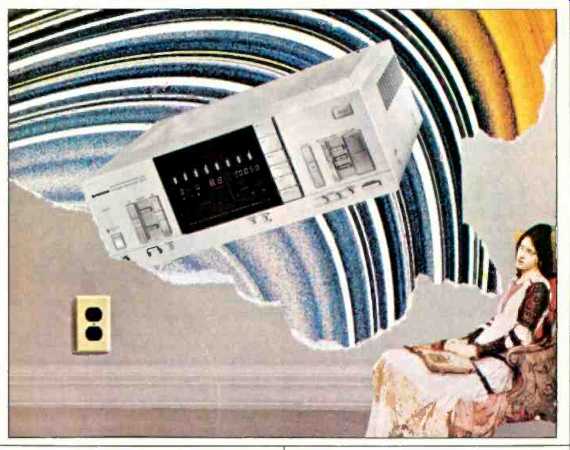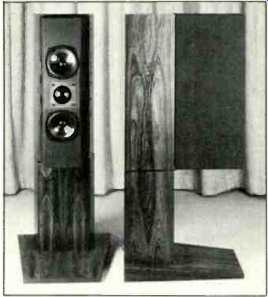
I have been working with digital recording since 1977 and have a profound respect for the entire spectrum of digital technology. Its implications are enormous and, barring the unforeseen, it will most likely be the technology of the future. However, there is no doubt that it will be quite a while before we attend the interment of analog audio. The continuity of analog audio is reflected in the proliferation of new products shown at the WCES in January, especially in the area of playback equipment for phonograph records.
Dynavector introduced two new moving-coil phono cartridges, the 17D and the 23R, as successors to their Diamond Karat and Ruby Karat cartridges. The top-of-the-line 17D features a diamond cantilever only 1.7 mm in length, said to be the world's shortest and less than a quarter the length of conventional cantilevers. The shortness of the cantilever and the extreme hardness of the diamond are intended to afford shorter transit time and near-perfect phase coherence of frequencies traveling from the stylus tip to the coils. The result is claimed to be improved clarity, faster transient response, and considerable attenuation of unwanted resonances. In fact, the resonant frequency of the 17D is well above 70 kHz. Because of this, no rubber damping is necessary in the moving system and performance should be unaffected by aging or extremes of temperature and humidity. By using a smaller cantilever, Dynavector reduced the size of the diamond, and this has brought down the cost from the $1,000 of the previous model to $650. The 23R cartridge uses ruby for its cantilever. Here, too, the 2.3-mm long cantilever is much shorter than that used in the earlier DV Karat Ruby model and in conventional cantilevers.
The same benefits afforded by the 17D accrue to the 23R. However, the resonant frequency is at 50 kHz, and the transit time through the cantilever is slower. Its price is $310.
Many audiophiles like a number of the features of moving-coil cartridges, but one drawback, the requirement for tracking forces in the range of 2 to 2.5 grams, has caused some to reject this type of cartridge. At the WOES, Denon introduced the DL 207 moving-coil cartridge which operates at a tracking force of 1.4 grams. A special boron cantilever and improvements in the moving system result in an effective tip mass of only 0.25 mg and a vertical compliance of 35 microdynes per centimeter. Frequency response extends to 60 kHz, so anyone who still plays CD-4 quadraphonic discs could presumably use this new model.
Sony has introduced the XL-88D, a very special moving-coil cartridge, as part of its prestigious Esprit audio system, but it is also available separately.
Like Dynavector's 17D cartridge, the XL-88D features a diamond cantilever, although the stylus and cantilever are integrated. Incredibly, the stylus and cantilever are laser-machined from a single diamond shaft, and Sony claims faster transit time and transient response because of this integrated design. Another advance is the use of a figure-eight shape for the coils, resulting in about twice the output voltage of conventional coils. The XL-88D is also capable of tracking at 1.5 grams, less than most moving-coil cartridges. The use of so much diamond in the stylus/ cantilever assembly is bound to be expensive, so the $1,000 price is not at all surprising.
As I have quite candidly admitted at other times, receivers are not my cup of tea. However, even the modestly priced receivers offered at the show have superior performance over the best preamps and amplifiers available only 12 to 15 years ago. The horsepower race in receivers is long since over, with the emphasis now on lower distortion and a multiplicity of features.
Receivers have become increasingly complex, and the new champion in this respect is probably the Pioneer SX-8. This 100-watt-per-channel stereo receiver has a microcomputer control center which handles almost every conceivable function. There are no rotary knobs or mechanical switches on this unit, because the microcomputer affords control of volume, loudness, muting, balance, function selection, bass and treble levels, and AM/FM tuning. The SX-8 will even commit these functions to a memory circuit. If the likes of "Space Invaders" turns you on, this kissin' cousin quite likely will satisfy your yen for flashing lights and automatic functions, all for a mere $800. In the area of esoteric electronics, Audio Research kept the faith for tube aficionados by offering a monster 400 watt mono amplifier. At $4,000 each, this adds up to $8,000 for the most expensive stereo amplifier extant.
Since these units are built in the frigid clime of Minnesota, perhaps they do double-duty as space heaters! Threshold has brought out a new line of preamplifiers and amplifiers with updated versions of their highly regarded Stasis technique. The amps do not employ overall corrective feedback, and the Stasis circuitry maintains a constant current/constant voltage linear state of operation. Threshold has applied the Stasis technology for the first time in preamplifiers with the $2,000 FET-One and $1,000 FET Two. The new Stasis stereo amplifiers are the 75 W/channel ST-150 at $2,000, the 150 W/channel ST-300 at $1,800, and the 250 W/channel ST-500 at $2,700. Top-of-the-line is the monophonic ST-1000, a brute of an amplifier putting out 500 watts per channel! This behemoth has 250-watt power transistors-72 per module-and allows a reserve capability of a staggering 125,000 watts! Slew rate has been increased to 80 volts/microsecond.
Acoustat, known for their fine electrostatic loudspeakers (at least 15 pairs of which were used for demonstration by manufacturers at the Jockey Club), has now introduced an unusual power amplifier, the Trans Nova Twin 200, priced at $995. Using patent-pending MOS-FET technology, with a new feedback circuit, this unit is rated at 200 watts per channel. Six power MOS-FET output transistors are used per channel, allowing high current capability. There is a great deal of new technology in this amplifier, said to combine the advantages of tubes and transistors. I heard the Acoustat Four speakers produce some lovely sounds when driven by the Trans Nova, especially in string tones.
Other amplifiers of note at the show were the Krell 200 W/channel amplifier, which is claimed to be pure Class A and is now in production, and Bedini's 100 W/channel version of their Mega Hertz amplifier series.
Spectral demonstrated their new DMC-10 in Las Vegas, a preamplifier which uses power MOS-FET transistors and is extremely fast. Teamed with a 150 W/channel Class A amplifier of their own design, this setup was used to drive a pair of Quad ESL 63 electrostatic loudspeakers. The combination was one of the best sounds at the WCES, with the fine electronics doing justice to the smoothness and accuracy of the Quad electrostatics.

above: Meridian three-way speaker.
Speakers that I would want to listen to a second time were rare at this show. Soundlab had a pair of big $6,000 full-range ES speakers which were very clean and smooth, with good low-frequency response. KEF's mid-price 303.3 is a very clean and well-balanced loudspeaker. Dick Shehinian of Shahinian Acoustics had one of the better sounds with his new three-way Eagle speakers which, at $450 each, had plenty of punch and great clarity with good imaging. The companion subwoofer, Diapason at $295 each, afforded a solid, tight bass extension that shook the room. In the Anglo-American rooms, the new larger "active" three-way Meridian speaker produced some very impressive sound, with exceptionally good imaging. Plenty of clean output here, with 150 watts on the woofer and 75 watts each on midrange and tweeter. Details were sketchy, but the price is tagged at $3,900 the pair. Also on hand was the B & W 801F, with the "F" standing for Fibrecrete. The midrange/tweeter head assembly is now made of polystyrene lined with glass fiber reinforced concrete, affording more than 10 dB reduction in resonance, with noticeably better transient response, better clarity and definition, and even an improvement over the vaunted 801's imaging and depth perception. Dealers will arrange exchange of the old 801 heads for the new "F" units, and the exchange price is around $300 per speaker.
It is apparent from the foregoing report that there were quite a number of worthwhile new audio products at the WCES. It is equally apparent that as this new audio equipment enables us to reproduce music with ever higher fidelity, the need for superior program material is more compelling than ever.
I was reminded of this when I ran into Larry Vittes of Brilly Corp. at the B & W room. Larry is a veritable storehouse of information on phonograph records, especially of the imported variety, and his company brings many interesting foreign label records into this country, not the least of which is EMI from England. A number of knowledgeable audiophiles seek out original EMI recordings from England rather than buy the same recordings pressed in this country by the affiliate Angel. Almost invariably, the EMI original is superior to the Angel pressing in terms of surface noise, dynamic range, and total fidelity of reproduction. Evidently Angel indulges in some "processing" which appears to include compression and equalization of the sound on their cutting master. There is much great classical music with superb performances and splendid sound on the EMI label, but purchasing these records in this country has been a problem. Original EMI recordings have been imported by several companies on a rather spotty basis, and they are difficult to obtain even in New York. Now Brilly brings in new EMI releases and, most importantly, catalog items on a regular basis. Distribution in key cities in the U.S. is being set up, but in the meantime, the EMI originals can be obtained directly from Brilly ( 155 North San Vicente Blvd., Beverly Hills, Cal. 90211; 213/658-5304). If you desire, Larry Vittes will send a list of "audiophile demonstration quality" EMI recordings, a group which contains many sonic blockbusters. Two outstanding records are Sir Malcolm Arnold's Symphony No. 2 and English Dances (ASD 3353) and Music of the Four Countries (ASD 2400) which includes the rousing overture, "The Wreckers." These recordings will give even the most sophisticated audio system a real workout!
-----------
(Audio magazine, May 1982; Bert Whyte )
= = = =